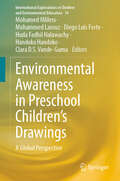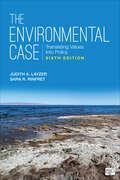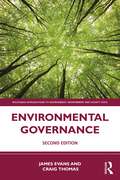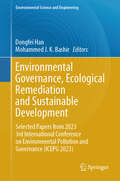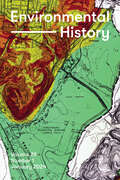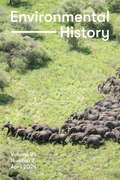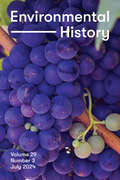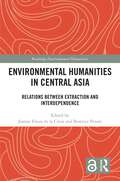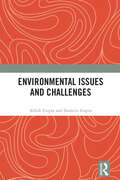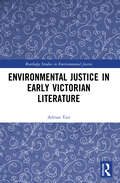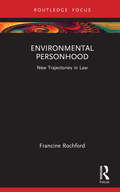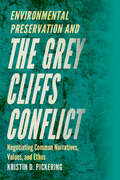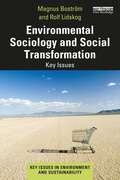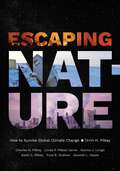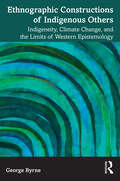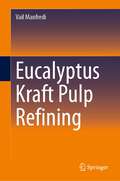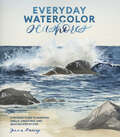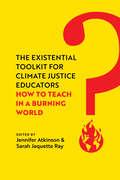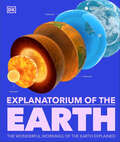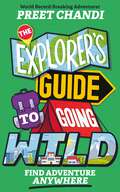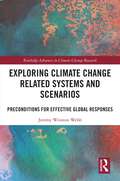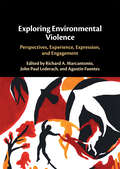- Table View
- List View
Environmental Awareness in Preschool Children’s Drawings: A Global Perspective (International Explorations in Outdoor and Environmental Education #14)
by Mohamed Mliless Mohammed Larouz Diego Luis Forte Huda Fadhil Halawachy Handoko Handoko Clara D. S. Vande-GumaThis edited volume investigates multiple perspectives of environmental meaning-making among children by evaluating preschool children’s drawings on the environment. It critically traces the formation of early attitudes towards the environment before children’s exposure to formal environmental education. Similarities and differences are explored among preschool children's drawings across diverse cultural and geographic backgrounds. Over five sections covering Morocco, Indonesia, Nigeria, Iraq, and Argentina, each one examines the factors affecting children's environmental drawings, such as age, gender, and geography. Using different theoretical frameworks, the chapters are written by researchers of environmental discourse and ecolinguistics with a background knowledge in environmental studies from a social science perspective. This book is of interest to researchers interested in ecolinguistics and socio-semiotics fields of study. This seminal book also paves the way for further research on preschool environmental education.
The Environmental Case: Translating Values Into Policy
by Judith A. Layzer Sara R. RinfretAnswers to environmental issues are not black and white. Debates around policy are often among those with fundamentally different values, and the way that problems and solutions are defined plays a central role in shaping how those values are translated into policy. The Environmental Case captures the real-world complexity of creating environmental policy, and this much-anticipated Sixth Edition contains 14 carefully constructed cases, including a new study of the Salton Sea crisis. Through her analysis, Sara Rinfret continues the work of Judith Layzer and explores the background, players, contributing factors, and outcomes of each case, and gives readers insight into some of the most interesting and controversial issues in U.S. environmental policymaking.
The Environmental Case: Translating Values Into Policy
by Judith A. Layzer Sara R. RinfretAnswers to environmental issues are not black and white. Debates around policy are often among those with fundamentally different values, and the way that problems and solutions are defined plays a central role in shaping how those values are translated into policy. The Environmental Case captures the real-world complexity of creating environmental policy, and this much-anticipated Sixth Edition contains 14 carefully constructed cases, including a new study of the Salton Sea crisis. Through her analysis, Sara Rinfret continues the work of Judith Layzer and explores the background, players, contributing factors, and outcomes of each case, and gives readers insight into some of the most interesting and controversial issues in U.S. environmental policymaking.
Environmental Governance (Routledge Introductions to Environment: Environment and Society Texts)
by James Evans Craig ThomasClimate change is prompting an unprecedented questioning of the fundamental bases upon which society is founded. Businesses claim that technology can save the environment, while politicians champion the role of international environmental agreements to secure global action. Economists suggest that we should pay developing countries not to destroy their forests, while environmentalists question whether we can solve ecological problems with the same thinking that created them. As the process of steering society, governance has a critical role to play in coordinating these disparate voices and securing collective action to achieve a more sustainable future. Environmental Governance is the only book to discuss the first principles of governance, while also providing a critical overview of the wide-ranging theories and approaches that underpin policy and practice today. It places governance within its wider political context to explore how the environment is controlled, manipulated, regulated and contested by a range of actors and institutions. This book shows how network and market governance have shaped current approaches to environmental issues, while also introducing approaches such as transition management and adaptive governance. In so doing, it highlights the strengths and weaknesses of the different approaches currently in play, and considers their political implications. This second edition has been comprehensively updated to build upon the success of the acclaimed first edition, with a new chapter on the environmental governance of outer space and updated analysis of international climate change summits. It provides a ground-breaking overview of dominant and emerging approaches of environmental governance, forging critical links between them. Each chapter has been updated with new case studies, key debates and figures, and includes questions for discussion and further reading. It is essential reading for students of the environment, politics and sociology, and, indeed, anyone concerned with changing society to secure a more sustainable future.
Environmental Governance, Ecological Remediation and Sustainable Development: Selected Papers from 2023 3rd International Conference on Environmental Pollution and Governance (ICEPG 2023) (Environmental Science and Engineering)
by Mohammed J. K. Bashir Dongfei HanThe book focuses on environmental monitoring, pollution discharge control and management, environmental pollution governance, ecological remediation technology, and environmental sustainability. With the rapid growth of global population and the development of industry and cities, environmental pollution problems are becoming increasingly serious, affecting people's lives and social development. In order to protect the environment and achieve sustainable ecological development, we need to maintain research on environmental pollution governance and ecological remediation. This book aims to promote scientific information interchange between scholars from the top universities, research centers, and high-tech enterprises working all around the world and is a valuable resource for those in both academia and industry.
Environmental History, volume 29 number 1 (January 2024)
by Environmental HistoryThis is volume 29 issue 1 of Environmental History. Environmental History (EH) is the world’s leading scholarly journal in environmental history and the journal of record in the field. Scholarship published in EH explores the changing relationships between humans and the environment over time. This interdisciplinary journal brings together insights from geography, anthropology, the natural sciences, and many other disciplines to inform historical scholarship.
Environmental History, volume 29 number 2 (April 2024)
by Environmental HistoryThis is volume 29 issue 2 of Environmental History. Environmental History (EH) is the world’s leading scholarly journal in environmental history and the journal of record in the field. Scholarship published in EH explores the changing relationships between humans and the environment over time. This interdisciplinary journal brings together insights from geography, anthropology, the natural sciences, and many other disciplines to inform historical scholarship.
Environmental History, volume 29 number 3 (July 2024)
by Environmental HistoryThis is volume 29 issue 3 of Environmental History. Environmental History (EH) is the world’s leading scholarly journal in environmental history and the journal of record in the field. Scholarship published in EH explores the changing relationships between humans and the environment over time. This interdisciplinary journal brings together insights from geography, anthropology, the natural sciences, and many other disciplines to inform historical scholarship.
Environmental Humanities in Central Asia: Relations Between Extraction and Interdependence (Routledge Environmental Humanities)
by Jeanne Féaux de la CroixThis book is the first collection to showcase the flourishing field of environmental humanities in Central Asia. A region larger than Europe, Central Asia possesses an astounding range of environments, from deserts to glaciated peaks. The volume brings into conversation scholarship from history to social anthropology, demonstrating the contribution that interdisciplinary and engaged research offers to many urgent issues in the region: from the history of conservationism to the tactics of environmental movements, from literary engagements with ‘pure nature’ to the impact of fossil fuel extraction. The collection focuses on the Central Asian republics of the former USSR, where a complex layering of nomadic and sedentary, Turkic and Persianate, Islamic and Soviet cultures ends up affecting human relations with distinct environments. Featuring state-of-the-art contributions, the book enquires into human-environment relations through a broad-brush typology of interactive modes: to extract, protect, enspirit and fear. Broadening the scope of analysis beyond a consideration of power, the authors bring into focus alternative local cosmologies and the unintended consequences of environmental policy. The volume highlights scholarship from within Central Asia as well as expertise elsewhere, offering readers diverse modes of knowledge-production in the environmental humanities. This book is an important resource for researchers and students of the environmental humanities, sustainability, history, politics, anthropology and geography of Asia, as well as Soviet and Post-Soviet studies.
Environmental Issues and Challenges
by Abhik Gupta Susmita GuptaThis book explores the field of environmental studies emphasizing its multidisciplinary nature. It looks at the fundamentals of environmental conservation and the management of sensitive ecosystems. The book provides an overview of the basic concepts used to understand and study diverse ecosystems and their functions as well as the progressively larger yet mutually inclusive units, such as the landscape and the biome. It examines the challenges towards preserving biodiversity which is under severe threat due to climate change, exploitation of natural resources, pollution, and man-made disasters. Besides outlining the causes and effects, the authors outline control mechanisms to keep pollution within safe limits and offer suggestions for resolving issues such as wildlife poaching and trade, water and air pollution, deforestation, and biodiversity loss through policy changes. This book will be of interest to the students, researchers, teachers of environmental studies, environmental science, sociology, political science, and public administration. This book will also be useful to environmentalists, wildlife conservationists, and policy makers.
Environmental Issues and Challenges
by Abhik Gupta Susmita GuptaThis book explores the field of environmental studies emphasizing its multidisciplinary nature. It looks at the fundamentals of environmental conservation and the management of sensitive ecosystems.The book provides an overview of the basic concepts used to understand and study diverse ecosystems and their functions as well as the progressively larger yet mutually inclusive units, such as the landscape and the biome. It examines the challenges towards preserving biodiversity which is under severe threat due to climate change, exploitation of natural resources, pollution, and man-made disasters. Besides outlining the causes and effects, the authors outline control mechanisms to keep pollution within safe limits and offer suggestions for resolving issues such as wildlife poaching and trade, water and air pollution, deforestation, and biodiversity loss through policy changes.This book will be of interest to the students, researchers, teachers of environmental studies, environmental science, sociology, political science, and public administration. This book will also be useful to environmentalists, wildlife conservationists, and policy makers.
Environmental Justice in Early Victorian Literature (Routledge Studies in Environmental Justice)
by Adrian TaitThis innovative new book combines environmental justice scholarship with a material ecocriticism to explore the way in which early Victorian literature (1837–1860) responded to the growing problem of environmental injustice. As this book emphasises, environmental injustice – simply, the convergence of poverty and pollution – was not an isolated phenomenon, but a structural form of inequality; a product of industrial modernity’s radical reformation of British society, it particularly affected the working classes. As each chapter reveals in detail, this form of environmental inequality (or ‘classism’) drew sharply critical reactions from figures as diverse as Thomas Carlyle, Friedrich Engels, Charles Dickens, and John Ruskin, and from within the Chartist movement, as working-class writers themselves reacted to the hazardous realities of a divided society. But as this book also reveals, these writers recognised that a truly just society respects the needs of the nonhuman and takes account of the material world in all its own aliveness; even if only tentatively, they reached for a more inclusive, emergent form of justice that might address the social and ecological impacts of industrial modernity, an idea which is no less relevant today. This book represents an indispensable resource for scholars and students working in the fields of Victorian literature, environmental justice, and ecocriticism.
Environmental Personhood: New Trajectories in Law (New Trajectories in Law)
by Francine RochfordThis book examines the increasingly widespread movement to recognise the environment as a legal person. Several countries have now recognized that nature, or parts of nature, have juristic personhood. In this book, the concept of legal personhood and its incidents are interrogated with a view to determining whether this is, or could be, a positive contribution to modern environmental problems. Surveying historical and current positions on the juristic concept of legal personhood, the book engages recent legislation and case law, in order to consider the attempt in several countries to vest personhood in rivers, river basins and ecosystems. Comparing approaches in a range of countries – including New Zealand, India, Ecuador, the United States and Australia, it addresses the methods employed, the purported aims, the mechanisms for enforcement, and the entrenchment of legal protections. Throughout, the book elicits the difficult relationship between an historically anthropocentric idea of personhood and its extension beyond the human; concluding that the attribution of personhood to the environment is an important, but limited, contribution to environmental sustainability. Accessibly written, this book will appeal to scholars, students and others with interests in environmental law, environmental science and public policy, and ecology more generally.
Environmental Preservation and the Grey Cliffs Conflict: Negotiating Common Narratives, Values, and Ethos
by Kristin D. PickeringBased on a qualitative, ethnographic, observational case study approach, Environmental Preservation and the Grey Cliffs Conflictpresents an analysis of the conflict negotiation between the U.S. Army Corps of Engineers and a local community that struggled to address a deteriorating Corps-managed recreational lake area in Tennessee known as “Grey Cliffs.” Viewing the dispute from the perspective of a new member of the community and a specialist in technical communication and professional writing, Kristin Pickering provides a unique perspective on this communication process. Though environmental degradation and unauthorized use threatened the Grey Cliffs recreational lake area to the point that the Corps considered closure, community members valued it highly and wanted to keep it open. The community near this damaged and crime-ridden area needed help rejuvenating its landscape and image, but the Corps and community were sharply divided on how to maintain this beloved geographic space because of the stakeholders’ different cultural backgrounds and values, as well as the narratives used to discuss them. By co-constructing and aligning narratives, values, and ethos over time—a difficult and lengthy process—the Corps and community succeeded, and Grey Cliffs remains open to all. Focusing on field notes, participant interviews, and analysis of various texts created throughout the conflict, Pickering applies rhetorical analysis and a grounded theory approach to regulation, identity, sustainability, and community values to analyze this communication process. Illustrating the positive change that can occur when governmental organizations and rural communities work together to construct shared values and engage in a rhetoric of relationship that preserves the environment, Environmental Preservation and the Grey Cliffs Conflict provides key recommendations for resolving environmental conflicts within local communities, especially for those working in technical and professional communication, organizational communication, environmental science, and public policy.
Environmental Sociology and Social Transformation: Key Issues (ISSN)
by Rolf Lidskog Magnus BoströmEnvironmental Sociology and Social Transformation demonstrates how sociological theory and research are critical for understanding the social drivers of global environmental destruction and the conditions for transformative change.Written by two professors of sociology who are deeply involved in the international community of environmental sociology, Magnus Boström and Rolf Lidskog argue that we need to better understand society as well as the fundamentally social nature of environmental problems and how they can be addressed. The authors provide answers to why so many unsustainable practices are maintained and supported by institutions and actors despite widespread knowledge of their negative consequences. Employing a pluralistic sociological approach to the study of social transformations, the book is divided into five key themes: Causes, Distributions, Understandings, Barriers, and Transformation. Overall, the book offers an integrative and comprehensive understanding of the social dimension of (un)sustainability, societal inertia, and conditions for transformative change. It provides the reader with references from classic and contemporary sociology and uses pedagogical features including boxes and questions for discussion to help embed learning.Arguing that a broad and deep social transformation is needed to avoid a global civilization crisis, Environmental Sociology and Social Transformation will be a great resource for students and scholars who are exploring current environmental challenges and the societal conditions for meeting them.
Escaping Nature: How to Survive Global Climate Change
by Orrin H. Pilkey Charles O. Pilkey Linda P. Pilkey-Jarvis Norma J. Longo Keith C. Pilkey Fred B. Dodson Hannah L. HayesIndustrial and agricultural greenhouse gas emissions are rapidly warming Earth’s climate, unleashing rising seas, ocean acidification, melting permafrost, powerful storms, wildfires, floods, deadly heat waves, droughts, tsunamis, food shortages, and armed conflict over shrinking water supplies while reducing nutritional levels in crops. Billions of people will become climate refugees. Hotter temperatures will allow tropical diseases to spread into temperate regions. Higher levels of CO2, allergens, dust, and other particulate matter will impair our physical and mental health and even reduce our cognitive abilities. Climate change disproportionately affects the world’s poor. It also harms Nature, and could ultimately trigger a sixth mass extinction. In Escaping Nature, Orrin H. Pilkey and his coauthors offer concrete suggestions for how to respond to the threats posed by global climate change. They argue that while we wait for the world’s governments to get serious about mitigating climate change we can adapt to a hotter world through technological innovations, behavioral changes, nature-based solutions, political changes, and education.
The Essential Guide to Wood Pallet Projects: 40 DIY Designs—Stunning Ideas for Furniture, Decor, and More
by Samantha Hartman Danny DarkeRustic meets modern with this charming do-it-yourself guide. Here are 40 easy-to-follow designs, ranging from coffee tables and wine racks to decorative wall art, all with step-by-step and clear full-color photographs. Perfect for those looking for simple and creative ways to decorate their homes. Wooden shipping pallets have found an unlikely second life: beautiful, handcrafted home décor without the designer price. The DIY market has long been drawn to refurbishing furniture and interior design on a budget, but easily accessible wood pallets have opened up all-new and inspiring ways to personalize a home in an eco-friendly, low-cost way. Beginner and veteran DIYers alike can take delight in crafting various furniture and décor that will impress and inspire without breaking the bank. Included within are instructions on how to make the following projects: Hanging ShelfDeck ChairWall-Hanging Mason Jar OrganizerPallet-Mounted Bottle OpenerWall-Mounted Coat RackSconcesDoor Handle Serving TrayPallet Arrow Wall ArtOutdoor Flower BoxFlower Arrangement CenterpieceClothes Pin Picture FrameRustic NightstandShabby Chic ToolboxFarmhouse Spice RackFarmhouse Wall ClockTealight Candle HoldersAnd more! With wooden pallets, the scope of the project is boundless, and warehouses and stores are happy to give them away for free. What was once a scavenger hunt and test of skill for experienced DIYers can now be an easy weekend project for even the newest of crafters. Take pride in creating imaginative home stylings with found and reclaimed materials that will help the environment, save you money, and make your home even more lovely!
Ethnographic Constructions of Indigenous Others: Indigeneity, Climate Change, and the Limits of Western Epistemology
by George ByrneThis book examines the ways in which indigeneity interacts with climate change politics at multiple levels and at the same time offers a self-critical reflection on the role of ethnographic research (and researchers) in this process. Through a multi-sited ethnography, it shows how indigeneity and climate change mitigation are at this point so intensely intertwined that one cannot be clearly understood without considering the other. While indigenous identities have been (re)defined in relation to climate change, it argues that Indigenous Peoples continue to subvert pervasive notions of the nature/culture dichotomy and disrupt our understanding of what it means to be human in relation to nature. It encourages students and researchers in anthropology, international development, and other related fields to engage in more meaningful reflection on the epistemic shortcomings of “the West”, including in our own research, and to acknowledge the ongoing role of power, coloniality, extractivism, and whiteness in climate change discourses.
Eucalyptus Kraft Pulp Refining
by Vail ManfrediThis book presents a brief history of papermaking followed by comments regarding wood as a source of fibers, including its chemical and anatomical characteristics and the influence of these aspects on the quality of the pulp produced. In addition, the author describes the effects of the pulping process, mainly a chemical process, on pulp quality and how these wood characteristics influence both the refining process as the quality of the final paper. The book further provides a broad discussion, based on experimental results, on the contribution of the main operating refining variables and the main strategies that can be used industrially to optimize the operating results. From this evaluation, the parameter that complements the specific edge load theory is identified. This parameter is related to the retention time of the fiber flocs inside the refiner.
Everyday Watercolor Seashores: A Modern Guide to Painting Shells, Creatures, and Beaches Step by Step
by Jenna RaineyFrom the Instagram artist behind Everyday Watercolor comes a beautiful step-by-step guide to painting shells, sea creatures, and oceanscapes in her effortlessly modern style.Jenna Rainey shares a gorgeously illustrated guide to painting a wide range of ocean-inspired subjects, from starfish and whales to beach landscapes and cresting waves. Featuring step-by-step instructions easy enough for beginners and inspiring for hobbyists, Rainey's fresh, contemporary illustrations bring more than thirty-five fishes, shells, sea creatures, corals, beaches, and ocean scenes to life. Everyday Watercolor Seashores is an accessible muse for the next generation of watercolor artists, creatives, and nature lovers alike.
The Existential Toolkit for Climate Justice Educators: How to Teach in a Burning World
by Jennifer Atkinson Sarah Jaquette RayAn easy-to-use field guide for teaching on climate injustice and building resilience in your students—and yourself—in an age of crisis. As feelings of eco-grief and climate anxiety grow, educators are grappling with how to help students learn about the violent systems causing climate change while simultaneously navigating the emotions this knowledge elicits. This book provides resources for developing emotional and existential tenacity in college classrooms so that students can stay engaged. Featuring insights from scholars, educators, activists, artists, game designers, and others who are integrating emotional wisdom into climate justice education, this user-friendly guide offers a robust menu of interdisciplinary, plug-and-play teaching strategies, lesson plans, and activities to support student transformation and build resilience. The book also includes reflections from students who have taken classes that incorporate their emotions in the curricula. Galvanizing and practical, The Existential Toolkit for Climate Justice Educators will equip both educators and their students with tools for advancing climate justice.
Explanatorium of the Earth (DK Explanatorium)
by DKWelcome to the Explanatorium of the Earth - the only Earth encyclopedia for children you'll ever need, with amazing photographs of everything from supervolcanoes to tsunamis.What makes volcanoes erupt? Why are tornadoes and hurricanes so destructive? How do rocks, fossils, and gems form? Explanatorium of the Earth takes you on an incredible voyage deep into the heart of our planet and back to discover the powerful forces that continually shape and remodel our ever-changing world. Discover how tectonic plates tear apart and collide, moving inch by inch to create continents, mountain ranges, oceans, and volcanoes. Witness the destructive power of earthquakes, tsunamis, and hurricanes. Learn how the slow but relentless process of erosion and weathering wear away rock, reducing mountains to dust and carving valleys and canyons into the land. And learn how the living world and rock cycles have worked together for millions of years to stabilize the planet's climate, keeping Earth suitable for life.
The Explorer's Guide to Going Wild: Find Adventure Anywhere
by Preet ChandiADVENTURE CAN BE FOUND JUST OUTSIDE THE DOOR A must-have book for kids who love to explore. Written by EXPLORER OF THE YEAR 2023, MBE Preet Chandi. Do you know a child who loves to explore but isn't sure how to plan their own adventures? Are they often preoccupied by an iPad when they could be outdoors? Then this is the perfect book for them! In this book, kids will learn how they can become a master explorer. Whether they want to learn how to camp in the wild, navigate their way through a new landscape, master bushcraft skills or plan a polar expedition, this book will show them how to do it.Each chapter has a mini challenge for young explorers to try at home, from learning how to read the stars to building a den. All these skills will help children to push their boundaries, build a resilient explorer mindset and get outdoors. And with fun black and white illustrations, having an adventure couldn't be easier! Written by world record-breaking adventurer 'Polar' Preet, who has been on adventures all around the world: from navigating 40 days on the Antarctic ice and a 700-mile journey to the South Pole to racing through the deserts of South Sudan. Preet shares tales of her own expeditions, big and small, as well as practical things kids can do, to inspire her readers to try new things and have their own adventures (even on their doorsteps!).Children will want to grab a copy, step outside and start creating their own adventure stories.
Exploring Climate Change Related Systems and Scenarios: Preconditions for Effective Global Responses (Routledge Advances in Climate Change Research)
by Jeremy Winston WebbJeremy Webb draws on multiple disciplines to piece together the climate change puzzle, identifying what it would take to limit climate change and its impacts.The book starts with a summary of the climate change problem and develops a Climate Change, National Interests, International Cooperation (CCNIIC) model of the climate response system. Webb reviews ‘reverse stress testing’, ‘backcasting’, and ‘theory of change’ methods, showing how they can be used to collect a large sample of possible futures. He also shows how we can explore the multiverse of futures using a new method called thematic chain analysis, finding relevant connections across scenarios. In the second half of the book, Webb explores 175 scenarios collected through 27 interviews with climate change experts. From these scenarios a signal response model is developed. Preconditions for effective social change and behaviour, political will and policy, as well as business and economic activity are synthesised. Lessons include preconditions for effective global responses to climate change, showing what it takes to limit climate change and related impacts. The book finishes with an epilogue, applying the signal response model and preconditions for effective global responses to COVID-19, demonstrating that models from this book can be applied to other global response problems – and used to quickly assess possible response strategies.This book will be of great interest to students and scholars of climate change, environmental policy and future studies.
Exploring Environmental Violence: Perspectives, Experience, Expression, and Engagement
by Agustín Fuentes John Paul Lederach Richard A. MarcantonioThe contributors to this book represent a wide breadth of scholarly approaches, including law, social and environmental science, engineering, as well as from the arts and humanities. The chapters explore what environmental violence is and does, and the variety of ways in which it affects different communities. The authors draw on empirical data from around the globe, including Ukraine, French Polynesia, Latin America, and the Arctic. The variety of responses to environmental violence by different communities, whether through active resistance or the creative arts, are also discussed, providing the foundation on which to build alternatives to the potentially damaging trajectory on which humans currently find themselves. This book is indispensable for researchers and policymakers in environmental policy and peacebuilding. This title is also available as Open Access on Cambridge Core.
